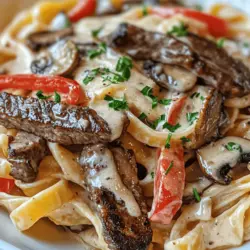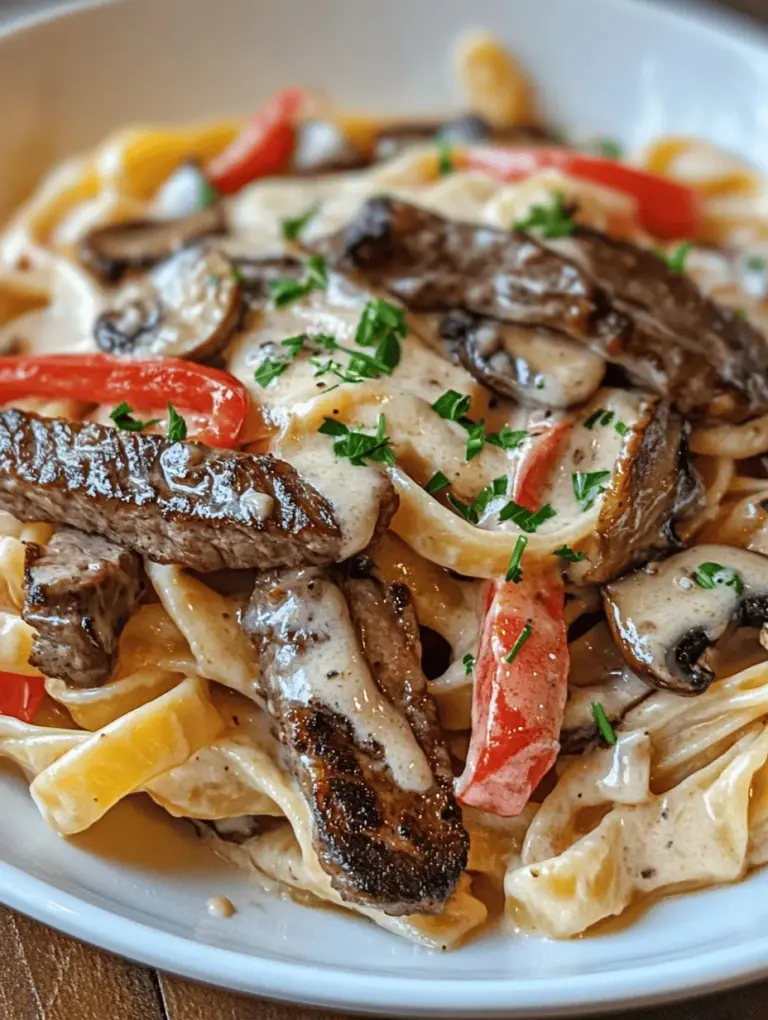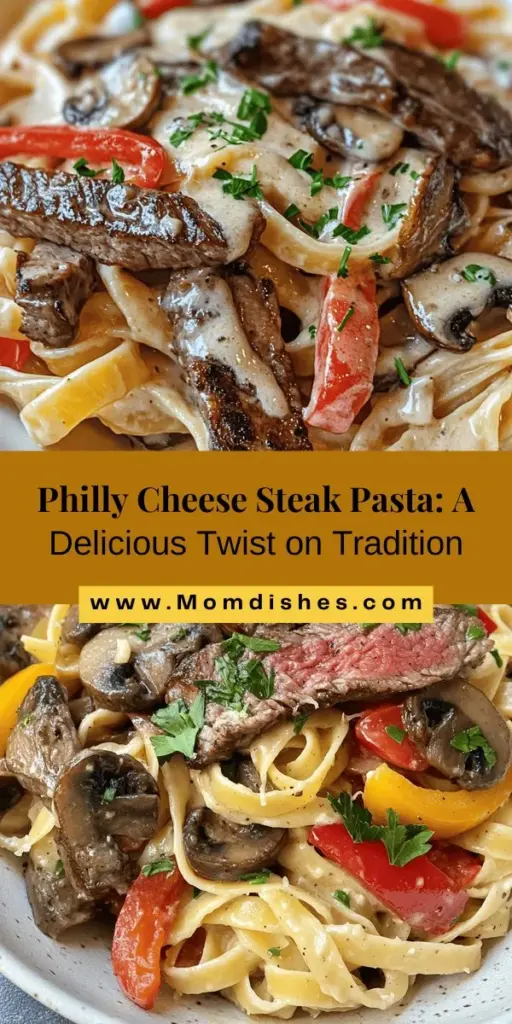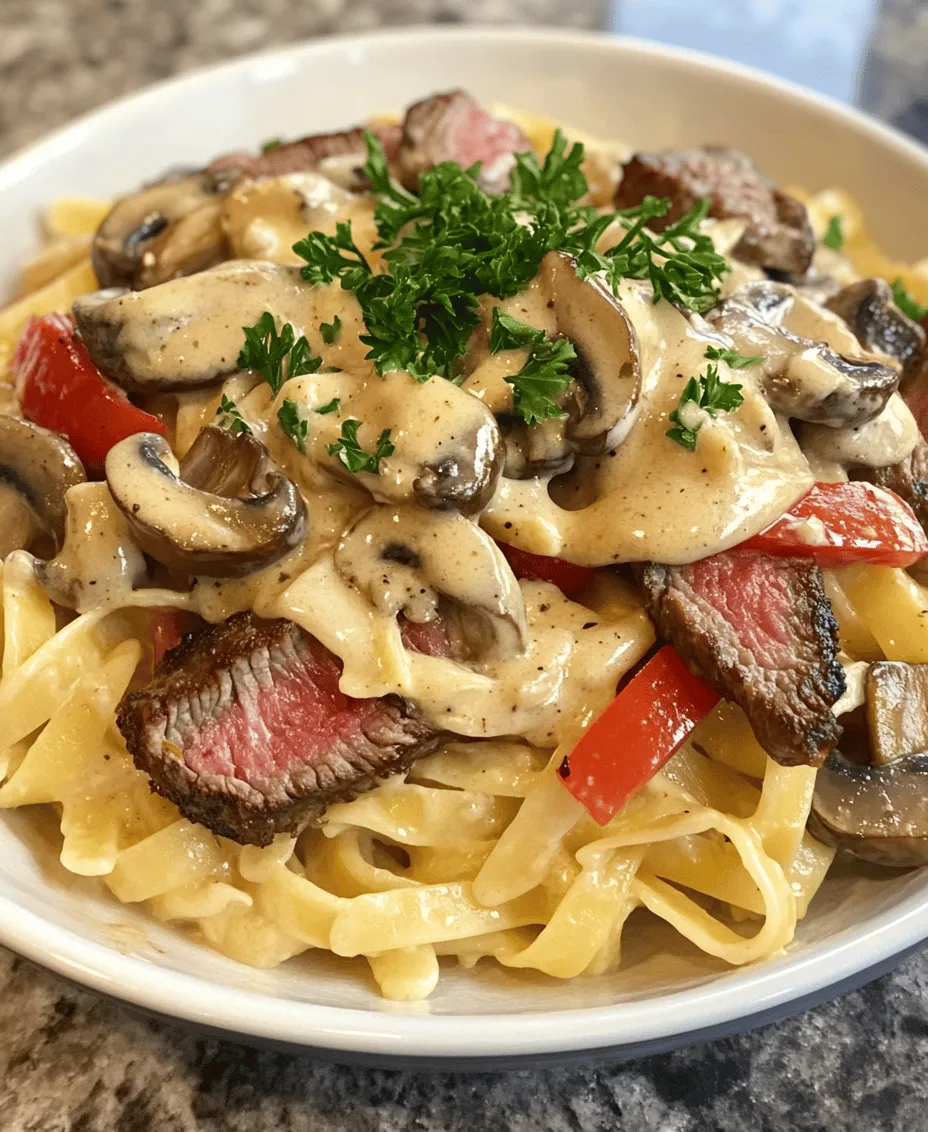Introduction
The Philly cheese steak sandwich is an iconic American dish that has captured the hearts—and appetites—of many. Originating from the streets of Philadelphia in the early 20th century, this beloved sandwich is made with thinly sliced steak and gooey melted cheese, all tucked inside a soft hoagie roll. Over the years, its mouthwatering flavors have inspired countless adaptations, one of the most delightful being the transformation into a pasta dish.
Philly Cheese Steak Pasta combines the classic flavors of the traditional sandwich with the comforting, hearty texture of pasta, creating a dish that’s not only delicious but also incredibly satisfying. This recipe offers a savory blend of tender steak, vibrant vegetables, and rich cheese, all enveloped in a creamy sauce that clings beautifully to fettuccine noodles. What’s more, this dish is simple and quick to prepare, making it an ideal choice for busy weeknight dinners.
In this article, we’ll explore the allure of Philly Cheese Steak Pasta, including its origins, the essential ingredients that make it shine, and a step-by-step guide to creating this delectable meal.
The Allure of Philly Cheese Steak Pasta
The roots of the Philly cheese steak can be traced back to the early 1930s, when a hot dog vendor named Pat Olivieri decided to whip up something different for his lunch. He grilled some beef and placed it on a roll, and the sandwich was born. It quickly gained popularity, and soon after, other vendors began to replicate Pat’s creation. Today, the Philly cheese steak stands as a symbol of Philadelphia’s rich culinary heritage, enjoyed by locals and visitors alike.
As food trends evolve, so too do classic recipes. The concept of Philly cheese steak pasta arose as a creative way to merge the beloved flavors of the sandwich with the comforting qualities of pasta. This dish keeps the essential elements of the original, such as tender ribeye steak and melted provolone cheese, but presents them in a new and exciting form.
Imagine twirling fettuccine pasta around your fork, coated in a rich and creamy sauce, with each bite bursting with flavor. The combination of sautéed onions and bell peppers, earthy mushrooms, and savory beef broth creates a depth of flavor that is reminiscent of the classic sandwich, yet entirely unique. This culinary fusion offers a delightful dining experience that is sure to please everyone at the table.
Ingredients Breakdown
To create the perfect Philly Cheese Steak Pasta, having the right ingredients is key. Here’s a breakdown of each component and its role in the dish:
Fettuccine Pasta
Fettuccine serves as the ideal base for this dish. Its flat, wide shape allows it to hold onto the creamy sauce beautifully, ensuring that each bite is a perfect balance of pasta and flavor. The texture of fettuccine also provides a satisfying chew that complements the tender steak and vegetables.
Ribeye Steak
Quality meat is essential for achieving the tender, flavorful result that makes this dish stand out. Ribeye steak, known for its marbling and rich flavor, is the perfect choice. When cooked properly, it remains juicy and tender, providing that classic steak experience that fans of the Philly cheese steak crave.
Olive Oil
Olive oil plays a crucial role in sautéing the steak and vegetables. It not only helps prevent sticking but also infuses the dish with flavor. The use of extra virgin olive oil can elevate the overall taste, adding a subtle grassy note that enhances the freshness of the ingredients.
Bell Pepper and Onion
These aromatic vegetables are vital for building the foundation of flavor in the dish. Sweet bell peppers and caramelized onions add a natural sweetness and depth, balancing the rich taste of the steak. Their vibrant colors also make the dish visually appealing, providing a pop of color against the creamy pasta.
Garlic
Garlic is a staple in many savory dishes, and for good reason. It adds depth and richness to the overall flavor profile, making the dish more aromatic and inviting. The addition of minced garlic during cooking enhances the savory notes and rounds out the taste.
Mushrooms
Mushrooms bring an earthy quality to the dish, contributing both texture and umami flavor. Their meaty consistency complements the steak beautifully, creating a well-rounded dish that is satisfying and hearty.
Beef Broth
Beef broth serves as the base for the sauce, infusing the dish with rich flavor. It adds moisture and depth, creating a luscious sauce that envelops the pasta and enhances the overall taste experience. Using a high-quality beef broth will make a noticeable difference in the final dish.
Heavy Cream
For that creamy, indulgent texture that sets this pasta apart, heavy cream is essential. It transforms the beef broth into a velvety sauce that clings to the pasta and adds a luxurious richness.
Provolone Cheese
The star of the show, provolone cheese ties all the flavors together. Its melting qualities make it perfect for this dish, creating that gooey, cheesy finish that is synonymous with Philly cheese steaks. The sharpness of provolone enhances the savory flavors of the beef and vegetables, making every bite a cheesy delight.
Salt and Pepper
Finally, salt and pepper are essential seasoning elements that elevate the flavors of the dish. They help to balance the richness and enhance the natural tastes of the ingredients, ensuring that each component shines through.
—
With these ingredients at the ready, you’re well on your way to creating a delicious and comforting Philly Cheese Steak Pasta that captures the essence of the classic sandwich while introducing a new twist. In the next section, we will delve into a step-by-step guide on how to bring this scrumptious dish to life, ensuring that you can easily replicate it in your own kitchen. Stay tuned for a mouthwatering culinary journey that will leave your taste buds dancing!
Fresh Parsley: Garnish and Flavor Contrast
Before diving into the detailed cooking instructions, let’s talk about the final touch that can elevate your Delicious Philly Cheese Steak Pasta: fresh parsley. This vibrant herb not only adds a splash of color to your dish, but its bright, slightly peppery flavor contrasts beautifully with the rich, savory elements of the pasta and steak. Finely chop fresh parsley right before serving and sprinkle it generously over your plated dish. This simple step enhances both the visual appeal and the overall flavor profile, making your meal even more enjoyable.
Step-by-Step Instructions
Cook the Pasta
To achieve perfect al dente pasta, begin by bringing a large pot of salted water to a rolling boil. The general rule is to use about 1 tablespoon of salt for every 4 quarts of water. Once boiling, add your pasta and stir it immediately to prevent sticking. Follow the cooking time indicated on the package, but start tasting the pasta about two minutes before the suggested time. You’re looking for a firm bite that still has a little chew—this is what al dente means.
Once cooked, drain the pasta in a colander, reserving about 1 cup of the pasta water. This starchy water will be a helpful addition to your sauce later, helping to achieve the perfect consistency. Rinse the pasta briefly under cold water if you plan to let it sit for a bit before combining with the sauce; this helps prevent it from becoming mushy.
Sauté the Vegetables
While your pasta is cooking, heat 2 tablespoons of olive oil in a large skillet over medium-high heat. Add sliced bell peppers and onions to the skillet. To achieve a beautiful caramelization and enhance the flavor, do not overcrowd the pan; this allows the vegetables to sear rather than steam. Sauté them for about 5-7 minutes, stirring occasionally, until they become tender and lightly browned.
If you like a bit of a kick, consider adding minced garlic in the last minute of cooking the vegetables. This will infuse the oil with a rich garlic flavor that complements the other ingredients beautifully.
Cook the Steak
Once your vegetables are cooked, transfer them to a plate and set aside. In the same skillet, add another tablespoon of oil if needed and increase the heat to high. Use thinly sliced steak (such as ribeye or sirloin) for the best results. Season the steak with salt and pepper before adding it to the hot skillet.
Cook the steak in batches if necessary; overcrowding will lead to steaming rather than searing. Allow each piece to cook undisturbed for about 2-3 minutes before flipping. You want a nice brown crust on the outside while keeping the inside tender and juicy. The ideal doneness for steak in this dish is medium-rare to medium, which retains flavor and moisture.
Make the Sauce
With the steak cooked, remove it from the skillet and set it aside with the vegetables. In the same skillet, pour in 1 cup of beef broth, scraping the bottom of the pan with a wooden spoon to deglaze—this will incorporate all those delicious browned bits into your sauce. Bring the broth to a simmer, allowing it to reduce by about half, which concentrates the flavors.
Next, lower the heat and slowly stir in 1 cup of heavy cream. This will create a rich, creamy sauce. Keep stirring until the mixture is well combined and heated through, but do not let it boil. If you prefer a lighter sauce, you can substitute half-and-half or a non-dairy cream alternative to suit your dietary needs.
Combine Ingredients
Once your sauce is ready, return the sautéed vegetables and cooked steak to the skillet. Stir to coat them evenly in the sauce, allowing everything to warm through. This step is crucial for ensuring that every bite of pasta is packed with flavor.
Toss with Pasta
Now, it’s time to bring it all together! Add the drained pasta directly into the skillet, tossing it gently to coat it evenly with the creamy sauce. If the mixture seems too thick, add a splash of the reserved pasta water until it reaches your desired consistency. This starchy water helps bind the sauce to the pasta, enhancing the overall dish.
Serve and Garnish
To plate your Delicious Philly Cheese Steak Pasta, use a large pasta fork or tongs to twirl the pasta into nests on each plate. This presentation not only looks appealing but also makes it easy for your guests to serve themselves. Finish with a generous sprinkle of freshly chopped parsley on top for that added freshness.
You might also consider serving this dish with crusty bread or a simple side salad to complement the richness of the pasta. A sprinkle of freshly grated Parmesan cheese can also add an extra layer of flavor if desired.
Nutritional Considerations
When enjoying Delicious Philly Cheese Steak Pasta, it’s important to consider the nutritional profile of the dish. Depending on the specific ingredients and portions used, a serving typically contains a balanced distribution of protein, fats, and carbohydrates.
– Protein: The steak provides a significant amount of protein, which is essential for muscle repair and overall health.
– Fats: The heavy cream adds richness and flavor, but it also contributes saturated fat. For a lighter option, consider using alternatives like Greek yogurt or low-fat milk.
– Carbohydrates: The pasta serves as the primary carbohydrate source, providing energy for your body.
For those looking to make the dish lighter, consider using whole wheat pasta for added fiber, or reducing the amount of cream and opting for a broth-based sauce instead.
Variations and Customizations
One of the great things about this recipe is its versatility. Here are a few variations you can explore based on dietary preferences or personal tastes:
– Vegetarian Alternatives: For a vegetarian version, swap the steak for plant-based steak substitutes or sautéed mushrooms, which have a hearty texture that mimics the original.
– Gluten-Free Options: If you’re looking to make this dish gluten-free, substitute regular pasta with gluten-free pasta varieties made from rice, quinoa, or chickpeas.
– Flavor Enhancements: Experiment with different types of cheese to enhance the flavor. Provolone, mozzarella, or even smoked gouda can add unique characteristics to the dish. Additionally, you can toss in other vegetables such as mushrooms, spinach, or zucchini for added nutrition and flavor.
Conclusion
Creating Delicious Philly Cheese Steak Pasta is a wonderful way to indulge in the comforting flavors of a classic Philly cheese steak while enjoying the hearty heartiness of pasta. With its rich creamy sauce, tender steak, and vibrant vegetables, this dish is perfect for family dinners, gatherings, or any occasion that calls for a satisfying meal.
Embrace this recipe as a versatile option that can be easily customized to suit any palate. Whether you choose to keep it classic or make it your own with variations, the joy of bringing these flavors together will surely delight your taste buds and those of your loved ones. Gather around the table and enjoy this delicious fusion of textures and tastes!



